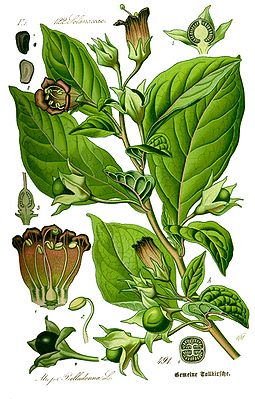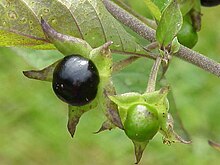Deadly nightshade
| Deadly nightshade | ||||||||||||
|---|---|---|---|---|---|---|---|---|---|---|---|---|

Black deadly nightshade ( Atropa belladonna ), illustration |
||||||||||||
| Systematics | ||||||||||||
|
||||||||||||
| Scientific name | ||||||||||||
| Atropa | ||||||||||||
| L. |
The deadly nightshade ( Atropa ) are a genus from the family of the nightshade family (Solanaceae). The only species native to Central Europe is the black deadly nightshade ( Atropa belladonna ), the fruits of which are poisonous.
description
Vegetative characteristics
The species of the genus Atropa are perennial, herbaceous, upright plants that are between 0.3 and 1.5 (rarely 2) m high. They can develop lateral rhizomes , are hairless or dense to sparsely hairy. The trichomes come in three different types: long-stemmed and with single-celled heads, long-stemmed and multi-celled heads, and a trichome type in which the oily secretions are first released through the cuticle , then the head cells are rejected and immediately replaced by new ones.
In the lower part of the plant there are single leaves , further up in pairs of differently shaped leaves. The leaf blade is ovate, oblong-ovate or elliptical, the tip is pointed or tapered, the base is wedge-shaped and runs down the short petioles . The size of the leaf blades can be 8 to 15 (22) × 3 to 8 (11) cm.
blossoms
Depending on the species, the hanging or upright flowers are usually solitary, only rarely in twos or threes in the axils of the stem . The flower stalks are (15) 20 to 25 (35) mm long. The bell-shaped calyx has a length of (10) 12 to 17 (21) mm, the short calyx tube is less than half as long as the five unequal or similar corolla lobes. These are triangular or egg-shaped-triangular, slightly protruding, tapering to a point or pointed. The crown is yellow or pale purple and becomes pale green towards the center, it is (19) 24 to 30 (35) mm in length. The coronet is short and wide, the five corolla lobes are wider than long (only in Atropa baetica as long as the corolla tube), rounded, slightly uneven and curved outwards.
The sexual parts of the flower are slightly or very clearly beyond the crown. The stamens are significantly longer than the anthers and only hairy at the lower point of attachment. The anthers have a size of (1.6) 2.6 to 2.8 (3.2) mm. The stylus is slightly bent, the scar is little head-shaped and irregular zweigelappt, moist and papillose . Flowering period: June to August
Fruits and seeds
The fruits are indented, spherical, mostly black, rarely also yellow berries with a diameter of 10 to 18 (20) mm. They stand on an enlarged calyx, the tips of which protrude clearly and contain many seeds, in Atropa baetica between 25 and 50, in Atropa belladonna up to 160. The seeds are kidney-shaped, the surface is small, the size varies depending on the species, between 1 , 7 and 2 × 1.2 and 1.5 mm for Atropa belladonna and 2.2 to 2.6 mm for Atropa baetica .
ingredients
Both roots , stems , leaves and fruits contain a large amount of alkaloids , in the leaves in concentrations from 0.14 to 1.4 percent, and in the roots of 0.27 to 0.69 percent. With 40 to 87 percent, the poison hyoscyamine (especially as atropine ) is most strongly represented, accompanied by apoatropine with 5 to 17.9 percent as well as scopolamine and in smaller amounts tropine , pseudotropin , tropinone and a few pyrrolidinic alkaloids such as hygrin , hygroline , Cuscohygrin etc. (values for Atropa belladonna , but similar in Atropa baetica .)
Systematics
In total, more than 70 botanical names have been described within the genus, but only about twelve of them correspond to the current generic scope. From a botanical point of view, only three species are adequately defined:
- Black deadly nightshade ( Atropa belladonna L. )
- Atropa acuminata Royle ex Lindl. , it occurs in India
- Atropa baetica Willk. , it occurs in southern Spain and Morocco.
etymology
The botanical name is derived from Atropos , one of the three goddesses of fate, the so-called Moiren , in Greek mythology.
See also
literature
- Armando T. Hunziker: The Genera of Solanaceae. ARG Gantner Verlag KG, Ruggell, Liechtenstein 2001, ISBN 978-3-904144-77-3 .


